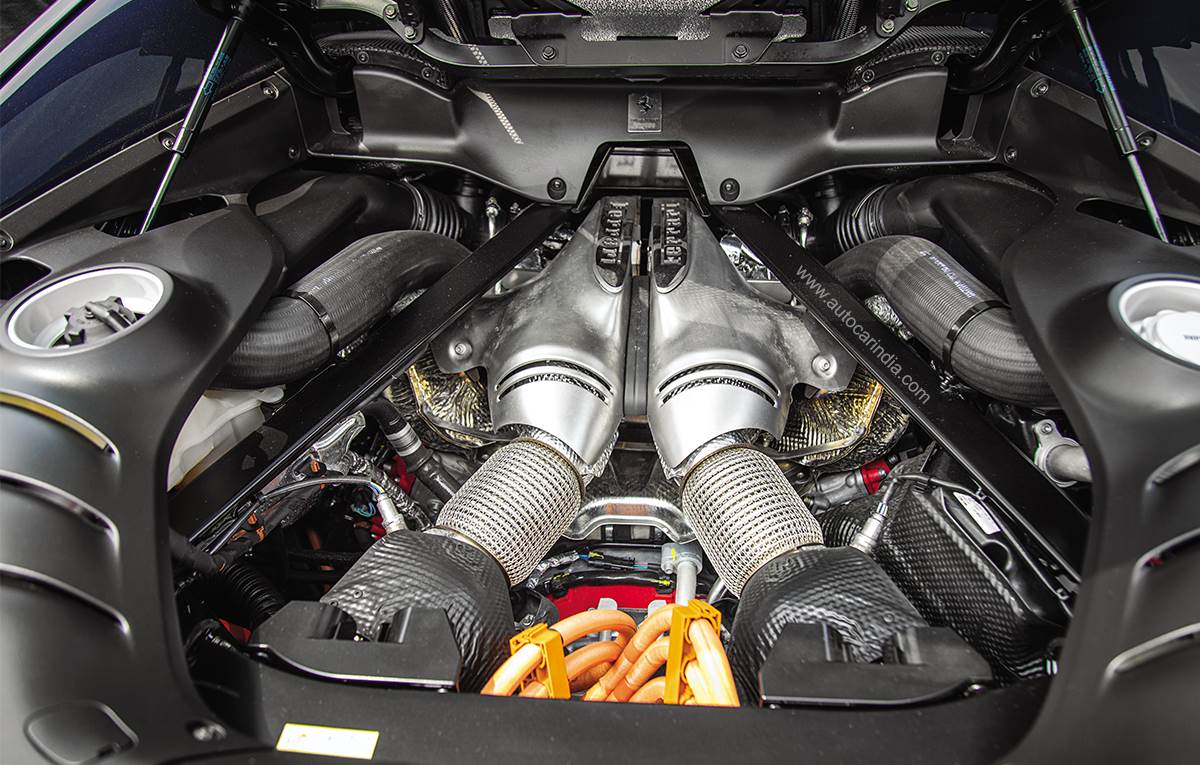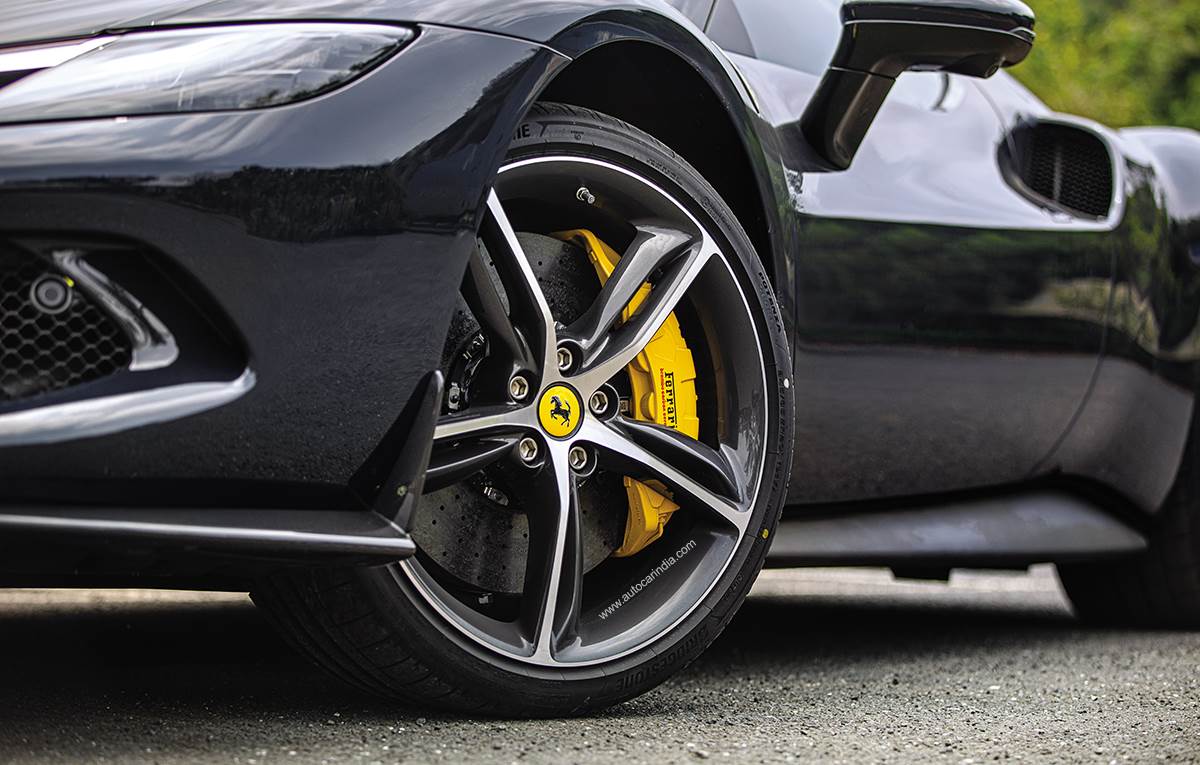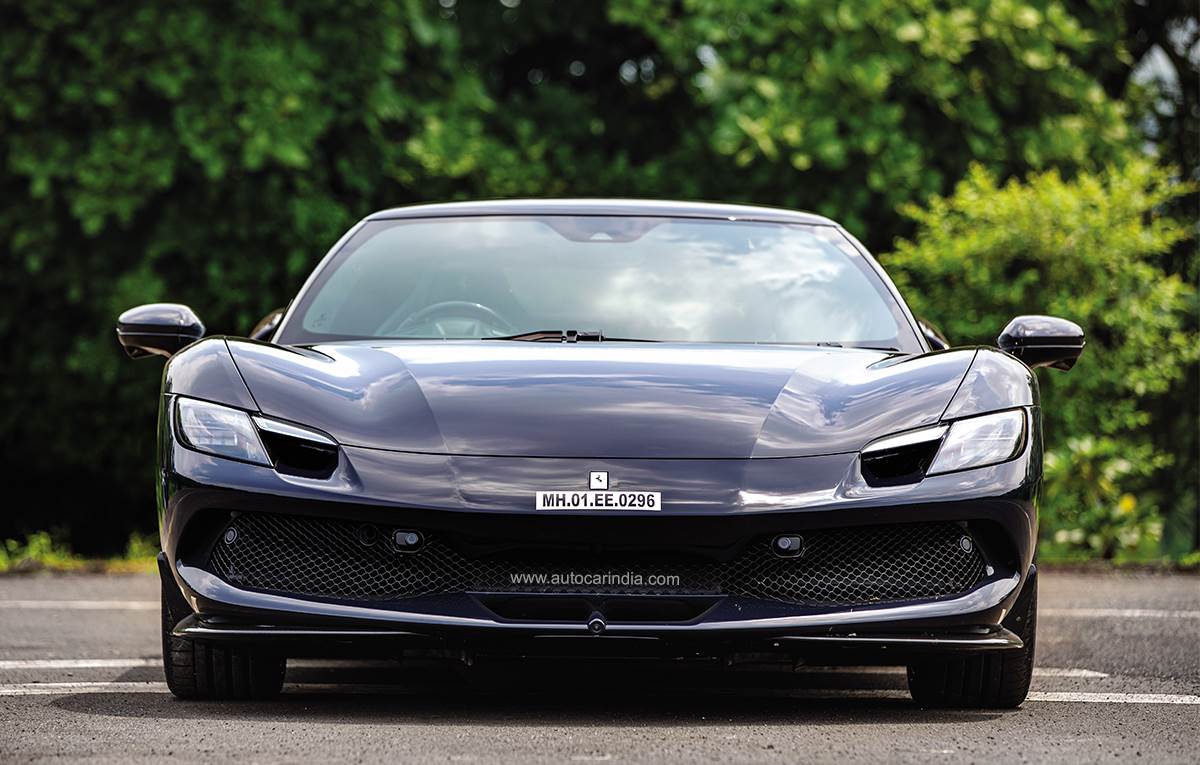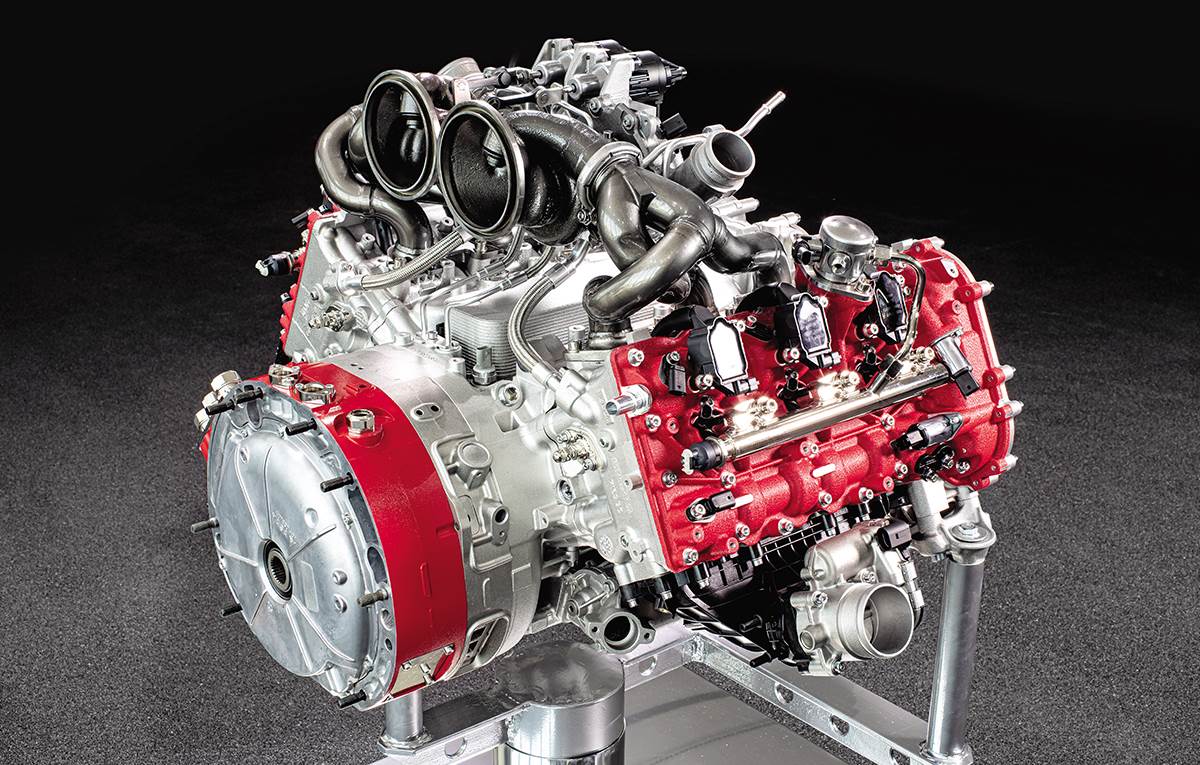It only has a 3.0 V6 and is part-electric. However, Ferrari’s future-proof 296 GTB is anything but a step back.
As I walk up to the 296 GTB, I feel a strong ‘thump-thump’ under my rib cage. For one, the low-slung menacing shape of the 296 GTB really gets me, especially the way its muscular shoulders catch the light. Then, as I swing open the light doors and step in, the seating position reminds me of a go-kart. It is low, really low, and tells me how serious Ferrari is about performance here.
Ferrari 296 GTB: performance
Most of the thumping in my chest, however, is down to the power output; not 500, not 600, not 700 but 830hp! Gulp. And then, just to make it more exciting, more agile, more nimble, this new mid-engine Ferrari is built on a wheelbase that is 50mm shorter. Who does that? And oh, did I mention, all of that 830hp goes through the rear wheels? Every last horse. So it’s 415hp per wheel. Yes, you have stickly 305 section rubber in the rear, and importantly, Ferrari’s award-winning electronic rear differential (e-diff). It puts the right amount of power to the right wheel, at just the right time. Still, this much power in a rear-wheel-drive chassis specifically tuned for agility will be challenging to drive.
Car starts in electric mode silently.
After the elevated heartbeat, the dryness in my throat and the cold sweat comes a big smile and plenty of laughter. I hit the capacitive button on the steering wheel to start the car, and nothing. So, I start in eD mode, might as well, the 296 is part-EV after all. It takes off with a bit of a whine and the e-drive even pulls forward smartly. It has a 7.45kWh battery, and this means you can drive around in pure-electric mode for around 25km. Much less if you pull it hard like I’m now doing, but it’s a Ferrari, so what the hell. It’s rapid too, it has 167hp, so you will be able to overtake other traffic. The e-drive isn’t only about being green, however. Ferrari’s colour is red and the e-boost’s job here is to bolster the bottom end of the combustion engine; give it torque fill, so it feels like you are driving a much larger engine.
Time to change modes. This is done via a fiddly capacitive touch button on the steering wheel. I skip Hybrid and go straight to Performance. The smile comes off. The elevated heartbeat and the thump-thump return. I wait for a gap in traffic and then gingerly mash down the throttle. I don’t go to 100 percent straightaway. Hell no. I use only around 60 percent, okay 65. Still, the 296 takes off like a cat on a hot plate. Seconds later, I am a long way down the road, hurled forward on a relentless torrent of power, with a demonic howl ringing in my ear. My foot comes right off the accelerator after a bit. What was that? 167hp of instant electric torque fill and around 400hp from the engine? My best guess, deep breath, Wow! I’ve just experienced something special, something that has got me beaming, laughing, giggling, and breathing hard, all at the same time. Flip, this is nuts.

Then I do it again, with even more resolve, in Qualifying mode, and the kick in the pants is even stronger. My face distorts, I stay pinned to the back of the seat, and as G-forces build, I find my fingers curling around the wheel, just hanging on. It’s as if someone has lit the afterburners. Why the relentless thrust? Well, it’s simple: first comes the instant hit of electric torque, WHAAM, then the howling V6’s peak torque of 740Nm comes in at 6,250rpm and finally around 8,000rpm comes the max combined power of 830hp; all falling over each other, each run up the powerband taking around a second and a half. And, unlike Ferrari’s twin-turbo V8s, this engine just loves to rev and rev; the redline is at 8,500rpm, not too far from the naturally aspirated 458’s 9,000rpm. And the tachometer positively whips up the dial. This is clearly Ferrari’s best turbocharged engine.
Then it’s SNAP into the next gear, and the cycle repeats itself every couple of seconds. By the time you hit third, things on either side of the cabin are a complete blur. 0-200kph comes up in 7.3sec. Take a few seconds to digest that. Please understand, this means that even keeping your foot flat for 5 seconds can get you to a serious speed. And how fast is it? Remember the Bugatti Veyron, the 1,001hp beast that first version that shocked the world? Well, the 296 GTB, at 1,470kg and 830hp, has a better power-to-weight ratio; 565hp per ton versus the Bug’s 530. Always wanted to drive a Veyron? Scratch that, drive this.

On a familiar road, the 296 just demolishes straights, gobbles them up. And every time you put your foot down, acceleration is manic, the road ahead a blur. What also adds to the drama is the muted howl from the exhaust. Ferrari says it sounds like a baby V12. Well, sort of. The 120-degree V6 has a nice howl and there’s a scream on the top. But the turbos get in the way of it sounding open, clean and clear, and the blare and volume you get on a naturally aspirated car are missing. Unlike Ferrari’s own trumpeting V12 scream, which has you swimming in sound and infiltrates you to your very core, this one is more an accompanying soundtrack. It’s much better than that of the turbo V8, that’s for sure.
Ferrari 296 GTB: handling
But it isn’t just the rabid pace that’s special. The 296 is also hyper agile. Traction from the rear is amazing, it seems to have the ability to put a humongous amount of power down, and the agility with which it turns into corners makes it feel like a track car.

The electric steering isn’t loaded with feel, and more feedback would have been nice, but it is quick, very direct and seems to steer the car into corners from the hip. And then what makes it easy to put all the power down is that it corners absolutely flat, only rolling marginally in tighter corners.
Going from Sport to Race also brings a degree of extra agility from the Side Slip Control. There’s a bit of slackness in the rear, I need to put in more steering input and then, at times, when accelerating out of corners with the weight predominantly over the rear wheels, the front wheels also seem to bob slightly over bumpier parts of the corners. But this only adds to excitement levels. Is the F8 better? Can’t be sure.

What also allows you to enjoy the performance is the brake by wire tech that works almost seamlessly, allowing you to brake late into corners without affecting entry speed, or more importantly, stability. The new braking system functions off more sensors, is more ‘aware’ of the grip levels on each tyre at any given moment, and even helps stabilise the car on the way through switchbacks.
Press the top of the Manettino, select ‘bumpy road’, and the 296 GTB will even ride well over our less than perfect tarmac. There’s more stiffness here than on the Roma and you can feel the underlying layer of stiffness, but considering the pace of the car the ride is pretty good and this adds a degree of practicality.

Also of great use is the lift system on the front axle. It takes a few seconds to activate, but once up, it allows you to cross even large speedbreakers, especially if taken at an angle. And this effectively means you can drive almost anywhere.
Ferrari 296 GTB: interior
Spending time behind the wheel in the 296 GTB is also no chore. The seats are a bit hard but beautifully built and pretty comfortable, the cabin has a real modern vibe to it and the digital instrument cluster and passenger screen double up nicely to give you all the info you need. Incredibly, there’s no central touchscreen, imagine that, but the Ferrari has space to store your phone safely, and that’s without it getting knocked around. There are three places you can do this – the central cup holder is quite deep, there’s a softened recess ahead of the cup holder, and a padded and scooped out section near your elbow. Ferrari owners carry multiple phones and now there’s plenty of space to secure them.

There’s even a degree of practicality with the 296: there’s space for a soft bag or two in the nose, so travelling short distances and spending a couple of days out of town is also possible.
Ferrari 296 GTB: verdict
This isn’t just another mid-engined supercar from Ferrari, it’s a landmark. Engineered for the future, and special even by Ferrari’s lofty standards, it blends cutting-edge Formula 1 tech, a healthy dose of green engineering and a forward-looking approach into a single cohesive unit. The phenomenal hybrid powertrain is on par or even better than Ferrari’s twin-turbo V8, especially the earlier ones. It loves to rev, and it’s incredibly potent. And then there’s the chassis, and the manner in which Ferrari has made all the performance accessible and useable; nothing short of a miracle.

The 296 GTB is even very usable in our difficult conditions. The ride is comfortable, the lift system makes it practical and then if you need to appease the greens, you can even drive it as a pure electric. Don’t recommend you do that for long stretches though, as you’ll be missing the best part: the manic performance. The step up from the F8’s price is quite a bit and the Rs 5.4 crore for a well-equipped car is pricey. Still, this is the best mid-engine Ferrari yet and that has to be worth a premium.
Formula 1 tech derived drive
The Ferrari produces 830hp from what is basically a 3.0 V6 engine and an e-motor. The set-up is similar to the one used in Formula 1. The engine makes 663hp and a high 221hp per litre, and the wide 120-degree vee configuration helps in packaging the big turbos in the ‘Vee’. To obtain this specific power output, the pressure in the combustion chamber had to be pushed to new heights, and Ferrari used its expertise in alloys to achieve this.

In addition, boost pressure on the IHI turbochargers has been increased by a huge 24 percent, and spool-up time has been reduced by lowering rotating masses significantly. The rear-mounted electric motor that produces up to 122kW (167hp) is also derived from the Formula 1 system and uses a similar MGU-K (Motor Generator Unit, Kinetic) unit to wind energy to the battery. The MGU-K uses a dual-rotor single-stator axial flux motor. Its compact size allows the length of the powertrain to be reduced, which in turn helps shorten the 296 GTB’s wheelbase.
Location courtesy: Saltt Karjat
Also see:
























